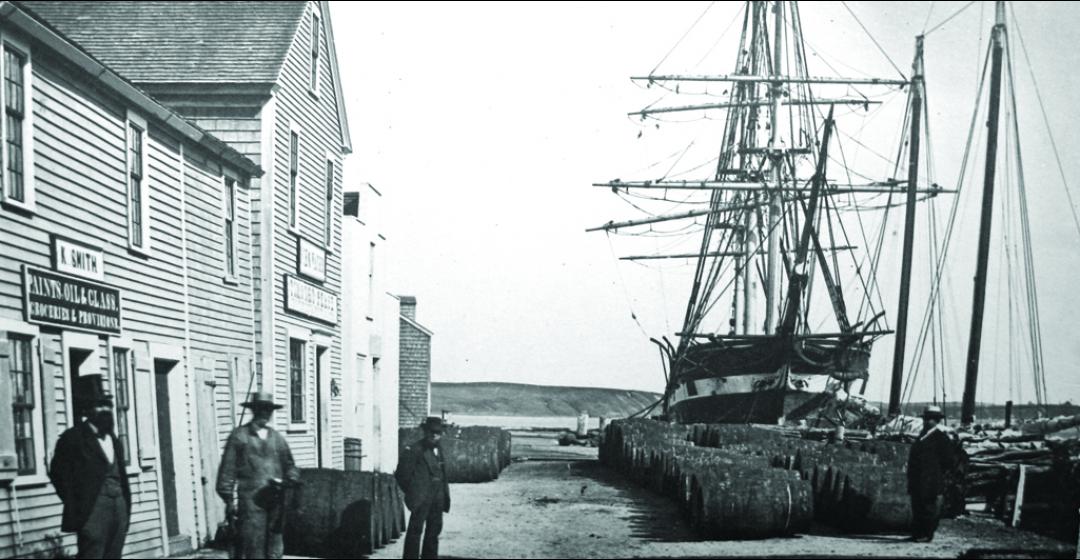Captain William A. Martin of Edgartown was that rarest of things, an African American Whaling Captain.
As difficult, dangerous, and sometimes financially unrewarding as whaling was, it still beat slavery by miles. By some estimates thirty percent of the thousands of whalers before the Civil War were minorities. A few even overcame all the odds and rose through the ranks to command ships. More than thirty African American whaling captains have been identified, one of whom, William A. Martin, was born on Martha’s Vineyard.
Martin’s great-grandmother was born in Guinea, Africa, and came to Chilmark as a slave in the mid 1700s. Her daughter Nancy Michael – the captain’s grandmother – was known as “Black Nance.” According to her obituary in the Vineyard Gazette in 1857, she was beloved by local children, and there were “few among us who have not at some time been indebted to her.” What’s more, she was thought to be a witch, whose remonstrations provided “good or bad luck to those bound on long voyages.”
Nancy Michael’s daughter Rebecca Ann, on the other hand, led a troubled life, marked by public drunkenness and misdemeanors. When Rebecca gave birth to William in 1827 in Edgartown, therefore, it fell mostly to Nancy to raise him. Neither woman lived to see William become Captain Martin, and though it’s amusing to wonder whether his grandmother’s supernatural powers contributed from beyond the grave to his success, the truth is he rose entirely by dint of his own talent and hard work.
He likely went to sea for the first time in his late teens, probably sailing on the Almira. Prior to the Civil War, it was rare for someone black to be able to read and write, but Martin had a good enough education from the Edgartown School to serve as log keeper on several of his early voyages. As the cooper and boatsteerer on the Waverly in 1851, he was paid more than the first mate, further attesting to his competence.
He became first mate and log keeper of the Europa on his next voyage, before sailing as joint first master on the Eunice H. Adams and finally as captain of the Clarice in the 1870s. He appears to have taken at least nine voyages before 1887, when the Eunice H. Adams, his last command, was damaged in a storm and he was injured. In that time his vessels brought back more than 2,658 barrels of the prized sperm whale oil, as well as valuable cargoes of other oil and whalebone.
In 1857 he married Sarah G. Brown of Chappaquiddick, who was mostly African American but also part Wampanoag. According to the July 11, 1907 Vineyard Gazette, they celebrated fifty years of marriage two months before his death that September, at the age of approximately eighty. He is buried on Chappaquiddick, where his and Sarah’s home still stands.
Little else remains of this remarkable man’s legacy, though one of his logbooks is at the Providence Public Library. In it, he wrote in 1853:
“Farewell to thee for a time
Days lingering sun is over
this heart will never awaken it
to one bright moment more
the hope
... cherished here within
day by day through life’s flow.”
Amos Smalley of Aquinnah, the Man Who Killed “the real Moby-Dick.”
In fiction, it was Tashtego of Gay Head who sighted Moby Dick, but in life it was Amos Smalley, also a Wampanoag of Gay Head (now Aquinnah), who was the only man known to have killed a white whale. It happened on a lovely day in 1902, somewhere off the coast of the Azores. Smalley was a member of the crew of the barque Platina of New Bedford and struck the sperm whale – “a big cuss,” he later told an interviewer.
Since sperm whales can live a hundred years, and white ones are extremely rare, it is possible that Smalley captured “the very whale that Melville had heard stories about before he wrote his novel a half-century earlier,” wrote Thomas E. Norton, then the director of what is now the Martha’s Vineyard Museum. Smalley died in Gay Head on March 7, 1962. He was the last whale harpooner from the Vineyard.
– Tom Dunlop





